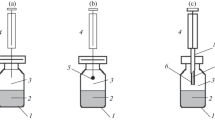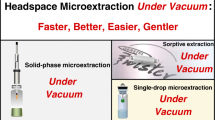Summary
Multiple headspace extraction (MHE) is an absolute quantitative method used in static headspace—GC. In principle it is dynamic gas extraction, carried out stepwise and establishing equilibrium conditions in each step. The concentration of the analyte in the headspace decreases exponentially during the series of extraction steps: by proper mathematical extrapolation the total peak area proportional to the total amount of analyte present in the original sample can be obtained.
This paper investigates MHE from the theoretical point of view using two approaches: a simplified theory regarding MHE as a first-order reaction, and a rigorous, step-by-step treatment of the MHE procedure. Special consideration is given to the fact that the headspace gas is only partially removed between individual steps. As shown, the results of both treatments are essentially the same hence the method is theoretically sound.
The practical limitations of MHE are also discussed pointing out how the analytical parameters may be adjusted to improve the possibility of determination by MHE.
Similar content being viewed by others
Abbreviations
- a:
-
Slope of linear plot
- A:
-
Peak area
- A1 :
-
Peak area obtained in first headspace extraction
- A2 :
-
Peak area obtained in second headspace extraction
- Ai :
-
Peak area obtained in ith headspace extraction
- An :
-
Peak area obtained in last headspace extraction
- b:
-
y-Intercept of linear plot
- c:
-
Concentration
- c1 :
-
Initial concentration
- ci :
-
Concentration of compound i
- c *G1 :
-
Concentration of analyte in the headspace volume of the vial, at equilibrium, in the first MHE step
- cG(1/2):
-
Concentration of analyte in the expanded volume of the headspace during venting
- c *G2 :
-
Concentration of analyte in the headspace volume of the vial, at equilibrium, in the second MHE step
- c *s1 :
-
Concentration of analyte in the sample present in the vial, at equilibrium, in the first MHE step
- cs(1/2) :
-
Concentration of analyte in the sample present in vial, during venting
- c *s2 :
-
Concentration of analyte in the sample present in the vial, at equilibrium, in the second MHE step
- f:
-
Quotient of geometric progression
- i:
-
Sequential number of a headspace extraction
- K:
-
Distribution (partition) coefficient of analyte at equilibrium, at the thermostatting temperature (=c *s /c *G )
- m1 :
-
Total amount of analyte present in the vial at the start of measurements
- m1/2 :
-
Total amount of analyte remaining in the vial after venting
- m2 :
-
Total amount of analytte in the vial in the second MHE step
- m *G1 :
-
Amount of analyte in the headspace volume of the vial, at equilibrium, in the first MHE step
- mG(1/2) :
-
Amount of analyte remaining in the headspace volume of the vial, after venting
- m *G2 :
-
Amount of analyte in the headspace volume of the vial, at equilibrium, in the second MHE step
- m *s1 :
-
Amount of analyte in the sample present in the vial, at equilibrium, in the first MHE step
- m *s2 :
-
Amount of analyte in the sample present in the vial, at equilibrium, in the second MHE step
- mv(1/2) :
-
Amount of analyte vented
- n:
-
Sequential number of last headspace extraction
- MHE:
-
Multiple headspace extraction
- Pa :
-
Atmospheric pressure
- Ph :
-
Pressure in the headspace of the vial in the first MHE step
- Po :
-
Pressure in the headspace of the vial after venting
- q:
-
Constant in the equation of first-order reaction
- q′:
-
Constant in the MHE calculation according to the empirical theory
- Q′:
-
Constant in the calculation of step-by-step investigation of MHE
- t:
-
Time
- VG :
-
Volume of the headspace (gas phase) in the vial
- VG(1/2) :
-
Volume of the gas originally present in the headspace at Ph, after it expanded and now having the pressure of Po
- VS :
-
Volume of sample in the vial
- Vv1 :
-
Vented volume of the headspace
- β:
-
Phase ratio of the vial (=VG/VS)
- ρ:
-
Ratio of two pressures (=po/Ph)
- *:
-
Asterisk refers to equilibrium conditions
References
B. Kolb, M. Auer, P. Pospisil, Angewandte Chromatographie-Applied Chromatography, No.35E (1981), Bodenseewerk Perkin-Elmer & Co., Überlingen, FRG.
B. Kolb, M. Auer, Lebensmitt. Chem. Gerichtl. Chem.35, 92–94 (1981).
B. Kolb, Chromatographia15, 587–594 (1982).
L. S. Ettre, E. Jones, B. S. Todd, Chromatogr. Newslett.12, 1–3 (1984).
B. Kolb, P. Pospisil, M. Auer, Chromatographia19, 113–122 (1984).
C. McAuliffe, Chem. Technol.1971, 46–51.
C. McAuliffe, U. S. Pat. 3,759,086 (1973).
M. Suzuki, S. Tsuge, T. Takeuchi, Anal. Chem.42, 1705–1708 (1970).
B. Kolb, P. Pospisil, Chromatographia10, 705–711 (1970).
A. Shinohara, A. Sato, N. Ishii, N. Onda, Chromatographia32, 357 (1991); a brief report was published in:K. Jinno, P. Sandra andT. Hanai (editors), Twelfth International Symposium on Capillary Chromatography (Kobe, Japan, September 11–14, 1990), Industrial Publishing & Consulting, Inc., Tokyo, Japan, 1990; pp. 151–157.
A. Venema, J. High Resolut. Chromatogr./Chromatogr. Commun.9, 637–649 (1986).
A. Venema, J. High Resolut. Chromatogr./Chromatogr. Commun.11, 128–131 (1988).
A. Venema, J. High Resolut. Chromatogr./Chromatogr. Commun.13, 537–539 (1990).
J. Gregoire, in:P. Sandra andW. Bertsch (editors), Sixth International Symposium on Capillary Chromatography (Riva del Garda, Italy, May 14–16, 1985), Huethig Verlag, Heidelberg, 1985; pp. 353–363.
L. S. Ettre, B. Kolb, Chromatographia32, 5–12 (1991).
M. Ja. Wygodski, Elementarmathematik Griffbereit, Vieweg, Braunschweig, 1973; pp. 101–103.
A. G. Vitenberg, T. L. Reznik, J. Chromatogr.287, 15–27 (1984).
F. A. Bencsath, K. Drysch, D. List, H. Weichardt, Angewandte Chromatographie-Applied Chromatography, No.32E (1978), Bodenseewerk Perkin-Elmer & Co., Überlingen, FRG.
B. Kolb, P. Pospisil, Chromatogr. Newslett.8, 35–37 (1980).
B. Kolb, M. Auer, Fresenius J. Anal. Chem.336, 297–302 (1990).
B. V. Ioffe, A. G. Vitenberg, Chromatographia11, 282–286 (1978)
Author information
Authors and Affiliations
Rights and permissions
About this article
Cite this article
Kolb, B., Ettre, L.S. Theory and practice of multiple headspace extraction. Chromatographia 32, 505–513 (1991). https://doi.org/10.1007/BF02327895
Received:
Accepted:
Issue Date:
DOI: https://doi.org/10.1007/BF02327895




